Bailey Bridge extends across the Queen Elizabeth Way at Applewood Village Plaza in Mississauga
A Bailey bridge, named after a British engineer, Donald Bailey, is a temporary bridge of lattice steel designed for rapid assembly from prefabricated standard parts, used especially in military operations, according to the Canadian Oxford Dictionary, Second Edition.
It’s also the name by which a permanent footbridge, across the Queen Elizabeth Way at Applewood Village Plaza in Mississauga, is known in the local community, according to John Walmark of Orchard Heights in Mississauga. It’s known as well as the Ogden Ave. Pedestrian Bridge. There are other pedestrian/trail bridges along the QEW including the East Hamilton Link Pedestrian Bridge and the Sand Plant Hill Bruce Trail Bridge. We owe thanks to Michael Chiu, Manager, Transportation Planning, and Partner, McCormick Rankin, for letting us know of these two additional footbridges over the QEW.
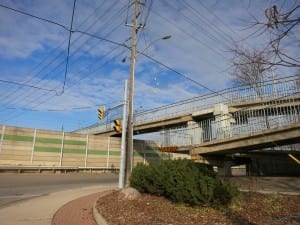
View of Bailey Bridge looking north from corner of Ogden Ave. and South Service Road. Jaan Pill photo
According to the QEW Improvements Study, Evans Avenue to Cawthra Road, the pedestrian bridge at Applewood Village Plaza was built in 1959. It’s owned and maintained by the City of Mississauga. The City is reviewing the condition and needs of the bridge independent of the above-noted QEW Study.
I met John Walmark at a Dec. 8, 2012 community meeting in Mississauga regarding the QEW from Evans Road to Cawthra Road. He mentioned that Dave Cook, president of the Applewood Acres Homeowners Association, has written about the history of the footbridge in Apple blossoms and satellite dishes: Celebrating the golden jubilee of Applewood Acres (2004).
John Walmark is active in his local community. He’s chair of MOCC (Mississauga Citizen Oversight Committee) and past president of the Orchard Heights Homeowners Association, and of the Applewood Acres Homeowners Association.
I’m familiar with the Bailey Bridge because for over a decade my morning route from Long Branch to my teaching job at Park Public School in Mississauga near Cawthra Road took me north along Dixie Road and west along the North Service Road. When I visited the bridge on Dec. 12, 2012 to take photographs, I saw groups of high school students walking across the bridge on their way to and from the plaza.
I do volunteer work with Mike James, who was principal at Munden Park during the years before I retired, in 2006, from teaching.
The bridge has an appealing ‘retro’ feel to it. This became evident when I spent time taking photographs of it. I like the look and feel of the bridge. It’s solid, friendly, and designed in a way that is sensible and to the point. I like how the ramps are arranged at either end. The design speaks of the best qualities that I remember about the 1950s. When I walked across the bridge I was struck by the speed and roar of the traffic along the QEW.
[As I revisit this page in February 2014, I would add that a related topic concerns the effect of the traffic on the air quality alongside such thoroughfares.]
Apple blossoms and satellite dishes (2004)
In his account of the history of the Bailey Bridge, Dave Cook notes that The Globe and Mail reported on Oct. 16, 1956 that the Toronto District Township Council had spoken in favour of a proposed footbridge across the QEW.
The fact that the new Gordon Grayson Memorial High School had opened on the south side of the four-lane highway had made the proposal a necessity, according to the article. Before the bridge was built, students had to walk more than a mile to the traffic lights at Dixie Road or take their chances with four lanes of traffic. In the early years, intersections along the highway were controlled by traffic lights; construction of overpasses at intersections commenced in the years that followed.
The president of the school’s student council, Mary Jane Miller, had contacted the area MPP, asking that a bridge be built from Ogden Avenue over the highway. The student council president was appointed following interviews, instead of through student elections. When selected for the position, Miller had just turned 15.
After a number of accidents, delegations from the school went to Queen’s Park, requesting a bailey bridge. Instead, the provincial government went a step further and provided a permanent footbridge.
Dave Cook quotes Mary Jane Miller, later a professor of dramatic literature at Brock University in St. Catharines: The story “began with a bad piece of suburban planning which put the newer part of Applewood Acres on one side of the Queen Elizabeth and Gordon Grayson Memorial Secondary School on the other.”
Miller noted that the QEW was in those years “inadequately fenced with ordinary farm fencing and wooden posts. Students quickly learned to cut holes in the wire then dash across the four-lane highway – inconceivable now, of course, and dangerous even then since the highway had 33,000 cars a day passing that point ( I can still remember the numbers).”
Toronto Telegram
What brought the issue to a head was the death of a young child who had wandered onto the highway through a hole in the fence. The student body had been looking for a project; the project they chose involved trying to get a bridge built over the highway. The students first conducted extensive research and signed a petition. As student council president, Mary Jane Miller made speeches to the Toronto Township Council, the Board of Education, and community organizations.

You can see a sign advertising The Toronto Telegram at Thomas Variety in Long Branch on the south side of Lake Shore Blvd. West near the corner of Long Branch Avenue. Jaan Pill photo
As a result of these efforts and discussions with local and provincial decision makers, the project met with strong political support including from The Toronto Telegram. Not everyone in the community favoured the bridge. Some students would have preferred to sit in a warm bus rather than walking across a footbridge in winter. When the bridge was built in 1959, Miller was in university. The Toronto Telegram folded in 1971.
In retrospect, Miller adds: “I learned that if you really work at something, stick your neck out and put pressure on the people in power, sometimes you can make a difference. Every time my husband and I drive into Toronto from St. Catherine’s on the QE there is the bridge, still standing after more than 40 years, to remind me that you can win a few.”
Dutch pedestrian-bicycle crossing
I’m very pleased, as well, to share information about this double strand bridge which I learned about through @PSFK on Twitter.
1909 Middle Road Bridge
Dave Cook notes that the construction of the QEW started in 1931; the highway was opened in 1939.
“According to the Ministry of Transportation Ontario, the need for the QEW [Queen Elizabeth Way] arose after the Toronto-Hamilton Highway (built in November 1917), and later known as Highway 2, became overloaded and a new route had to be considered. The Dundas (Hwy.5) was also at its capacity. As a result, planning began for the Middle Road, which became the Queen Elizabeth Highway.
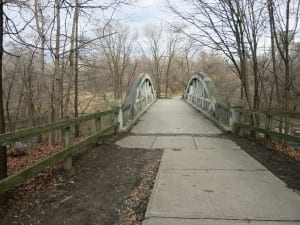
View of Middle Road Bridge looking east from eastern limit of Sherway Drive in Mississauga. Jaan Pill photo
“At this point it should be noted that the Queen Elizabeth Highway did not follow along the original alignment of the Middle Road. The best example of the Middle Road can be seen at the eastern limit of Sherway Drive. The bridge that spans the Etobicoke Creek is in fact the historic Middle Road Bridge. It was also nicknamed ‘White Bridge’.
“This particular bridge stands out above all others as it was the first of its kind ever built in Canada, and only the second of its kind ever built in North America. The bridge was designed in 1909 by Frank Barber and C.W. Young. It’s a concrete truss or tied arch bridge and was celebrated for its light weight and strength. The bridge was tested on opening day when 40 cattle were herded across its span. On October 14, 1986, I had the pleasure of co-officiating the ceremony with Etobicoke Mayor, Dennis Flynn, that designated this bridge as a heritage structure. This bridge became the only structure in Ontario to be designated and renovated jointly by two municipalities.”
Additional photos related to the Middle Road Bridge can be found here. [Click on link in previous sentence.]


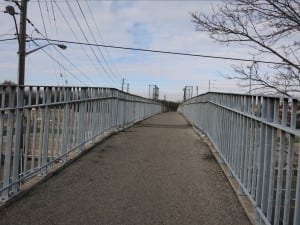
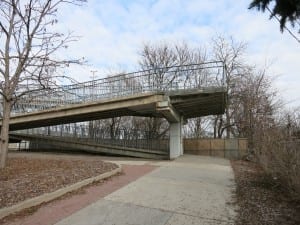
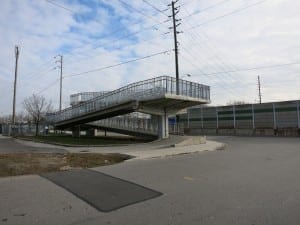
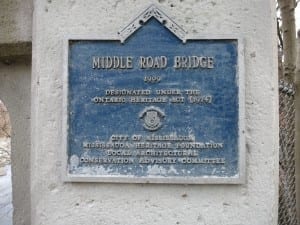
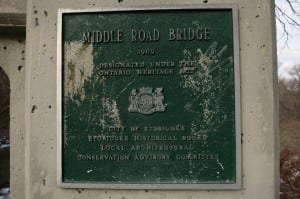
Leave a Reply
Want to join the discussion?Feel free to contribute!